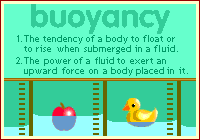 Archimedes was an ancient Greek mathematician, physcist, and inventor who lived from 287 - 212 B.C. (www.encyclopedia.com) One of his most famous works was his discovery concerning bouyancy. The bouyant force is the upward force of the fluid on an object. He found that the volume of the immersed object is and always will be the same as the volume of the displaced fluid.(Merrill, p. 270) The buoyant force on a body has the same magnitude as the weight of the fluid displaced by the body, where m is the mass of liquid displaced and g is the gravitational acceleration. Therefore the equation for the bouyant force is F = mg or F = pVg. (Weisstein) In the second equation, p stands for the liquid's density (which equals the weight per unit of volume), V stands for the object's volume, and g stands for gravity. the buoyant force DOES NOT depend on the weight of the submerged object, but rather the weight of the displaced fluid.(Merrill, p. 270) The buoyant force is always upward or opposite gravity. Furthermore, the pressure on submerged objects is greater on the parts that are most deeply submerged.(http://www.britannica.com) Archimedes' principle applies to objects of all densities. Therefore according to Archimedes' principle, if an object's density is greater than that of the fluid, the bouyant force will be less than the object's weight and the object will sink. Likewise if the object's density is less than that of the fluid, the object will float.(Merrill, p. 270)
 Today scientists measure the density of liquids with hydrometers. These instruments apply the principle of flotation, which states that when an object floats, the object's weight is equal to the weight of the displaced fluid. The most important thing to remember about Archimedes' principle is that the submerged portion of the object will only displace a volume of fluid with a weight equal to the object's weight.(Merrill, p.270) These two pictures are of the vessel known as FLIP. FLIP, which stands for a Floating Instrument Platform, is a research vessel that studies waves in deep water. FLIP is towed into position floating horizontally. Then water is pumped into the stern tanks, which causes the vessel to flip into the vertical position. (Merrill, p. 270) FLIP takes advantage of Archimedes' principle in the same way that submarines do. Both vessels pump water into or out of chambers to rise or sink. Also, fish use Archimedes' principle because they have air sacs which allow them to adjust their density so they can sink and rise in the water.(Merrill, p.270) |


